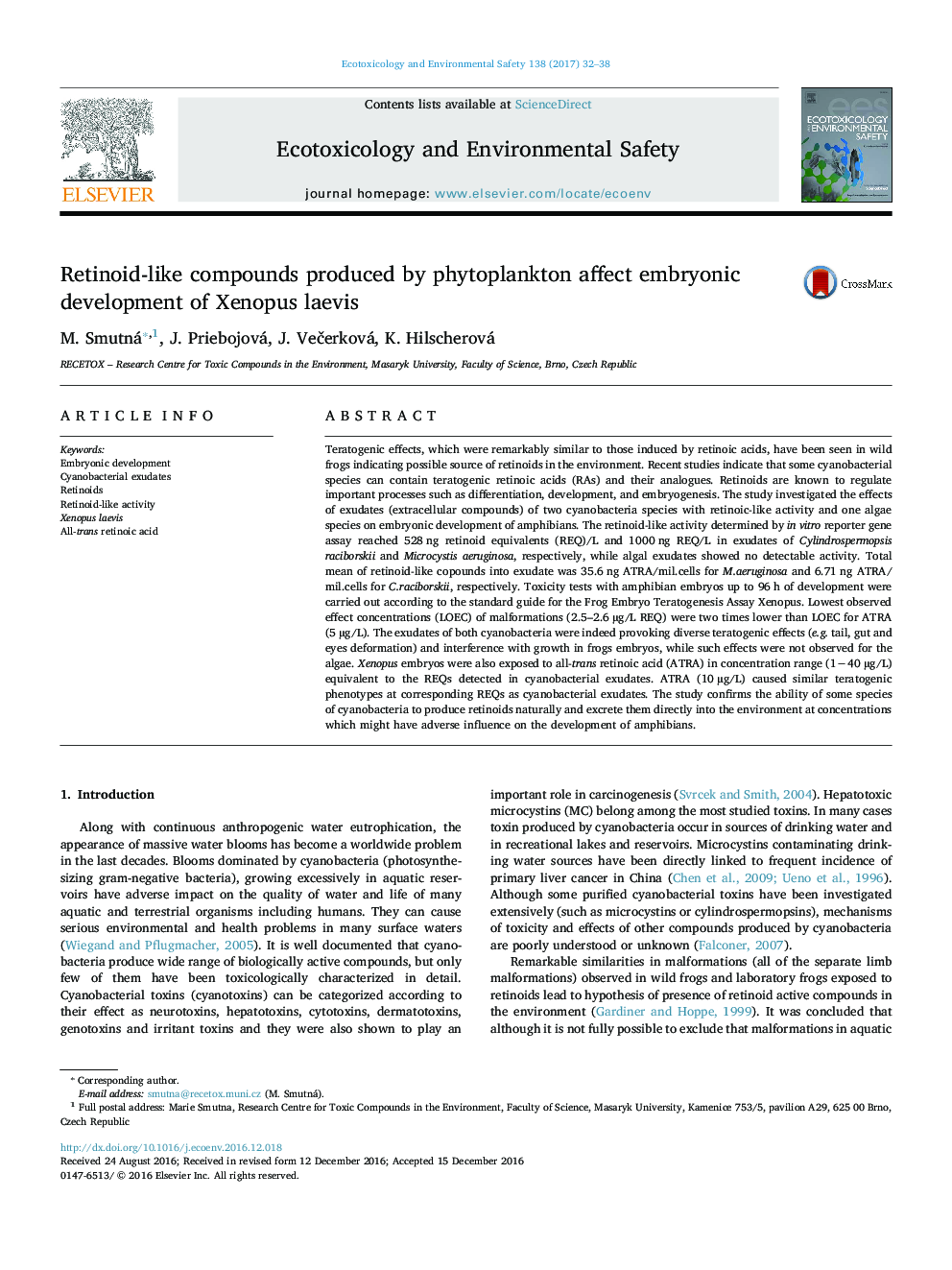| کد مقاله | کد نشریه | سال انتشار | مقاله انگلیسی | نسخه تمام متن |
|---|---|---|---|---|
| 5747938 | 1618926 | 2017 | 7 صفحه PDF | دانلود رایگان |
عنوان انگلیسی مقاله ISI
Retinoid-like compounds produced by phytoplankton affect embryonic development of Xenopus laevis
دانلود مقاله + سفارش ترجمه
دانلود مقاله ISI انگلیسی
رایگان برای ایرانیان
کلمات کلیدی
موضوعات مرتبط
علوم زیستی و بیوفناوری
علوم محیط زیست
شیمی زیست محیطی
پیش نمایش صفحه اول مقاله

چکیده انگلیسی
Teratogenic effects, which were remarkably similar to those induced by retinoic acids, have been seen in wild frogs indicating possible source of retinoids in the environment. Recent studies indicate that some cyanobacterial species can contain teratogenic retinoic acids (RAs) and their analogues. Retinoids are known to regulate important processes such as differentiation, development, and embryogenesis. The study investigated the effects of exudates (extracellular compounds) of two cyanobacteria species with retinoic-like activity and one algae species on embryonic development of amphibians. The retinoid-like activity determined by in vitro reporter gene assay reached 528 ng retinoid equivalents (REQ)/L and 1000 ng REQ/L in exudates of Cylindrospermopsis raciborskii and Microcystis aeruginosa, respectively, while algal exudates showed no detectable activity. Total mean of retinoid-like copounds into exudate was 35.6 ng ATRA/mil.cells for M.aeruginosa and 6.71 ng ATRA/mil.cells for C.raciborskii, respectively. Toxicity tests with amphibian embryos up to 96 h of development were carried out according to the standard guide for the Frog Embryo Teratogenesis Assay Xenopus. Lowest observed effect concentrations (LOEC) of malformations (2.5-2.6 µg/L REQ) were two times lower than LOEC for ATRA (5 µg/L). The exudates of both cyanobacteria were indeed provoking diverse teratogenic effects (e.g. tail, gut and eyes deformation) and interference with growth in frogs embryos, while such effects were not observed for the algae. Xenopus embryos were also exposed to all-trans retinoic acid (ATRA) in concentration range (1â40 µg/L) equivalent to the REQs detected in cyanobacterial exudates. ATRA (10 µg/L) caused similar teratogenic phenotypes at corresponding REQs as cyanobacterial exudates. The study confirms the ability of some species of cyanobacteria to produce retinoids naturally and excrete them directly into the environment at concentrations which might have adverse influence on the development of amphibians.
ناشر
Database: Elsevier - ScienceDirect (ساینس دایرکت)
Journal: Ecotoxicology and Environmental Safety - Volume 138, April 2017, Pages 32-38
Journal: Ecotoxicology and Environmental Safety - Volume 138, April 2017, Pages 32-38
نویسندگان
M. Smutná, J. Priebojová, J. VeÄerková, K. Hilscherová,